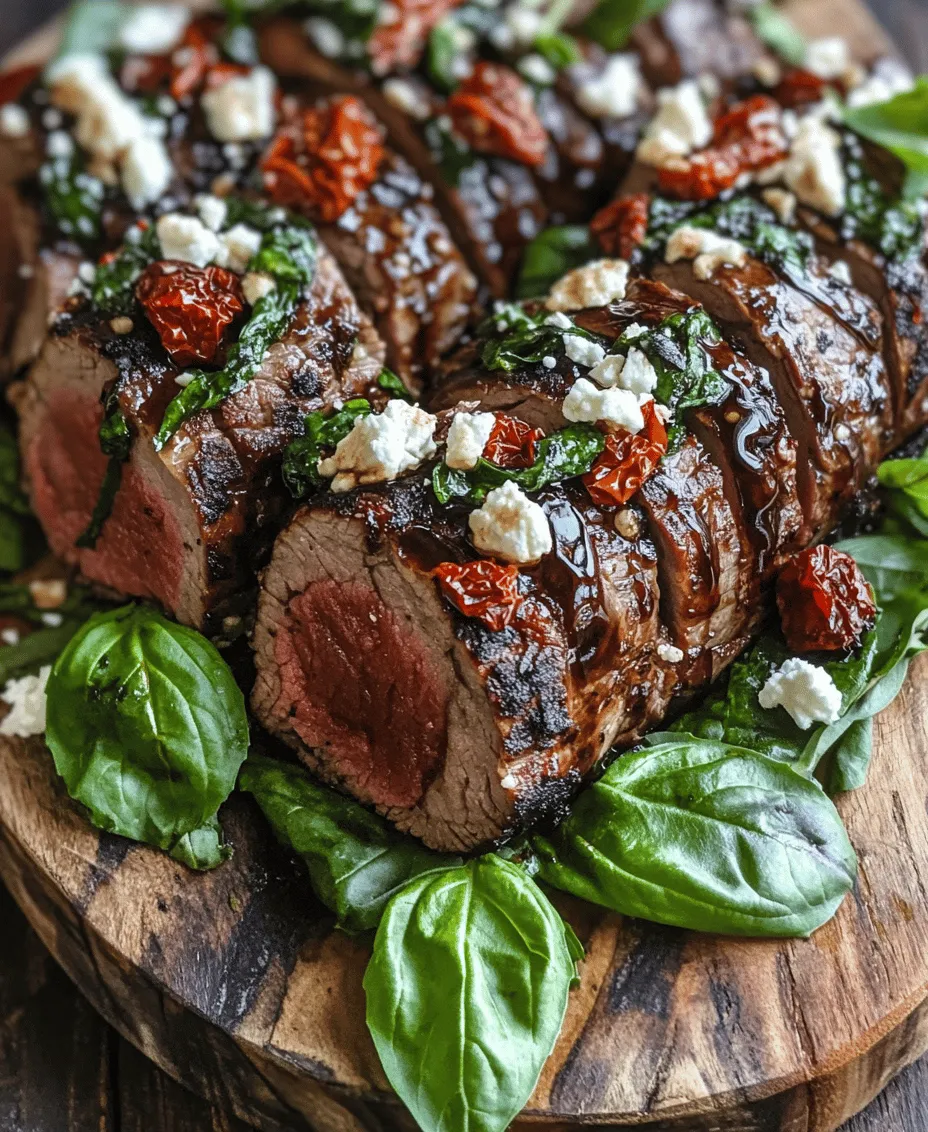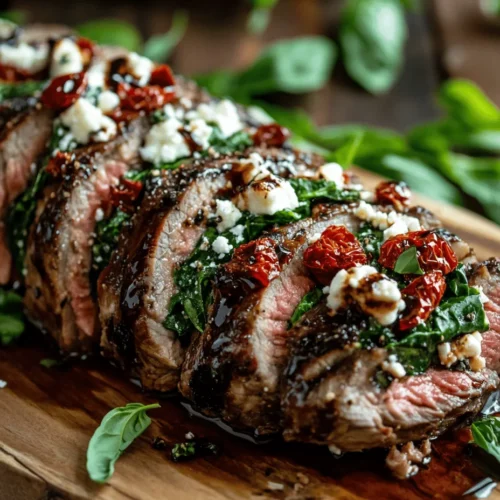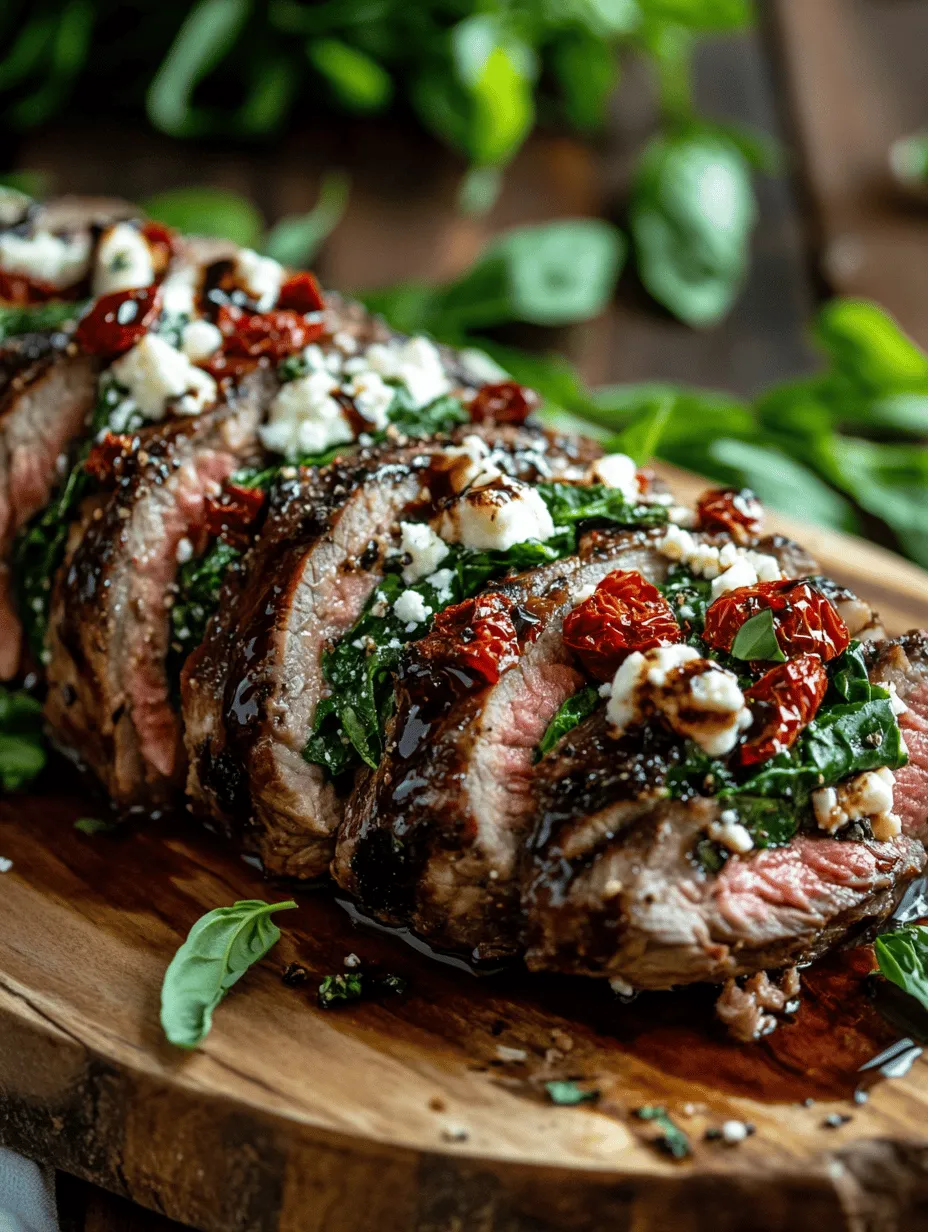Introduction
Flank steak is a culinary gem that boasts versatility and robust flavor, making it a favorite among chefs and home cooks alike. This long, flat cut of beef is known for its rich taste and is often used in a variety of dishes, from tacos to stir-fries. But when it comes to creating a stunning centerpiece for your next gathering or special occasion, nothing beats a flank steak roulade. This dish transforms a simple cut of meat into an impressive and mouthwatering presentation that will surely leave your guests in awe.
A roulade, which comes from the French word “rouler,” meaning “to roll,” is a technique that involves rolling a filling inside a piece of meat. In this case, the flank steak is tenderized and filled with a delectable mixture of fresh ingredients, then rolled up and cooked to perfection. The result is a dish that not only looks stunning but also combines a variety of flavors and textures. With Mediterranean influences, this flank steak roulade is filled with vibrant ingredients that elevate the beef to new culinary heights. Imagine the combination of savory feta cheese, earthy spinach, and tangy sun-dried tomatoes, all wrapped up in juicy, marinated steak. It’s a showstopper that is sure to impress!
Understanding Flank Steak
Before diving into the recipe, it’s essential to understand what flank steak is and why it’s an excellent choice for this roulade. Flank steak is cut from the lower chest or abdominal muscles of the cow, known for its lean profile and distinct grain. This cut is relatively flat and can weigh anywhere from 1.5 to 2.5 pounds. When cooked properly, flank steak is incredibly tender and flavorful, making it an ideal candidate for a roulade.
One of the primary benefits of using flank steak for this dish is its ability to absorb marinades, allowing for enhanced flavor. The muscle fibers of flank steak are relatively long, which means that they can be somewhat tough if not cooked correctly. However, by pounding the steak to an even thickness and marinating it, you can ensure that it remains tender and juicy after cooking. Flank steak is also relatively affordable compared to other cuts, making it a great option for entertaining without breaking the bank.
From a nutritional standpoint, flank steak is a powerhouse of protein, boasting about 26 grams of protein per 3-ounce serving. It is also a good source of iron and vitamin B12, both of which are essential for maintaining energy levels and overall health. By incorporating flank steak into your diet, you’re not only treating yourself to a delicious meal but also providing your body with important nutrients.
Ingredients Breakdown
To create a mouthwatering flank steak roulade, you’ll need a selection of fresh, high-quality ingredients. Here’s a detailed list of what you’ll need, along with tips on sourcing and utilizing each component.
Flank Steak
The star of the show is, of course, the flank steak. When selecting your flank steak, look for a cut that has a deep red color with minimal visible fat. Freshness is key, so if possible, purchase from a local butcher or a reputable grocery store. Grass-fed options are often more flavorful and nutritious. Typically, you’ll need about 1.5 to 2 pounds of flank steak for a roulade that serves 4 to 6 people.
Olive Oil
Olive oil plays a crucial role in both flavor and cooking. It not only helps to marinate the steak effectively but also contributes to the overall richness of the dish. Extra virgin olive oil is preferred due to its robust flavor and health benefits, including heart-healthy monounsaturated fats and antioxidants.
Garlic
Garlic is another essential ingredient that enhances the flavor profile of the roulade. Its aromatic qualities bring depth to the dish, while also providing numerous health benefits, such as anti-inflammatory and immune-boosting properties. Fresh garlic is recommended for the best results, but you can also use garlic powder if fresh is not available.
Spices
The seasoning of your flank steak is vital for developing its flavor. A simple blend of salt, black pepper, and smoked paprika will elevate the dish significantly. Salt enhances the natural flavors of the meat, while black pepper adds a subtle heat. Smoked paprika introduces a lovely smokiness that complements the beef beautifully.
Filling Components
The filling is where the magic happens! Here’s a breakdown of the key components that will make your roulade burst with flavor:
– Spinach: Fresh spinach adds a pop of color and nutrients, including vitamins A, C, and K. It also provides a mild, earthy flavor that pairs well with the other ingredients.
– Sun-Dried Tomatoes: These little flavor bombs pack a punch! Their concentrated sweetness and tanginess contrast beautifully with the savory elements of the dish. They also add a chewy texture that enhances the overall mouthfeel.
– Feta Cheese: Crumbled feta cheese brings a creamy, salty aspect to the filling. Its tanginess balances the sweetness of the sun-dried tomatoes and complements the earthiness of the spinach.
– Basil: Fresh basil adds a fragrant note to the filling, with its slightly sweet and peppery flavor. It also ties in the Mediterranean theme of the dish.
Substitutions and Variations
If you have dietary preferences or restrictions, there are plenty of ways to adapt this recipe. For a vegetarian version, consider substituting the flank steak with a large portobello mushroom cap or eggplant. You can also create a filling that includes roasted vegetables, ricotta cheese, and herbs.
For those who may be gluten-sensitive, ensure that any store-bought ingredients, like sun-dried tomatoes, do not contain added gluten. Lastly, if you’re looking for a lower-fat option, consider using chicken breast or turkey instead of flank steak, though the flavor profile will differ slightly.
Preparation Steps Explained
Now that you have a clear understanding of the ingredients, it’s time to dive into the preparation of the flank steak roulade. Here’s a step-by-step guide to help you achieve the perfect roulade.
Step 1: Preparing the Flank Steak
The first step in preparing your flank steak is to pound it to an even thickness. This process tenderizes the meat and ensures even cooking. Place the flank steak between two pieces of plastic wrap or parchment paper and use a meat mallet or rolling pin to gently pound it until it is about ½ inch thick. Be mindful not to overdo it, as you want to maintain the integrity of the meat.
Step 2: Marinating the Steak
Marinating is an essential step that infuses the meat with flavor. In a large bowl, whisk together olive oil, minced garlic, salt, black pepper, and smoked paprika. Place the pounded flank steak into the marinade, ensuring that it is completely coated. Cover the bowl with plastic wrap and let it marinate in the refrigerator for at least 1 hour, or ideally, overnight. This allows the flavors to penetrate the meat fully and enhances tenderness.
Step 3: Preparing the Filling
While the flank steak is marinating, you can prepare the filling. In a medium bowl, combine the fresh spinach, chopped sun-dried tomatoes, crumbled feta cheese, and chopped basil. Mix thoroughly to ensure that the ingredients are well-distributed. You may also want to season the filling with a pinch of salt and pepper to enhance its flavor.
Step 4: Balancing Texture and Flavor
When creating the filling, aim for a balance of textures and flavors. The creaminess of the feta, the chewiness of the sun-dried tomatoes, and the freshness of the spinach should all complement one another. Consider adding a squeeze of lemon juice for a bright, zesty finish that will elevate the entire dish.
Once the filling is mixed, set it aside until the flank steak has completed its marinating process. This will allow the flavors to meld together while you prepare for assembly.
Assembling the Roulade
With the flank steak marinated and the filling prepared, you are now ready to assemble your roulade. The next steps will guide you through this exciting process, ensuring a successful outcome that will impress all who partake in this culinary delight.

Visualizing the Assembly Process
When it comes to creating a flank steak roulade, visualization is key to achieving that showstopper effect. Begin by laying your flank steak flat on a clean cutting board, with the grain of the meat running horizontally. This orientation is crucial, as it will ensure that when you slice the roulade, each piece showcases beautiful layers of filling and tender meat.
Next, spread your chosen filling evenly across the steak, leaving a small border around the edges. This is essential for preventing any fillings from spilling out during the rolling process. Common fillings may include spinach, roasted red peppers, goat cheese, or a mixture of herbs and spices. Once the filling is distributed, take a moment to appreciate how vibrant and colorful it looks against the dark meat.
Now, the rolling technique comes into play. With the edge closest to you, begin rolling the steak away from you, tucking the filling in tightly as you go. The goal is to create a snug cylinder without squishing the filling out. Think of it as rolling up a sleeping bag—tight and secure. As you roll, keep an eye on the edges; if they start to expand, gently press them back in to maintain the structure of the roulade.
Once the steak is completely rolled, it’s time to secure it. This is where kitchen twine becomes invaluable. Cut about 5-6 pieces of twine, each approximately 18 inches long. Start by tying one end of the roulade tightly, ensuring that the filling is held in place. Use a simple knot, but make sure it is secure. Continue tying the twine at intervals of about 1-2 inches along the length of the roulade. This not only helps in maintaining the shape during cooking but also allows for even slicing later.
Cooking the Roulade
Searing the Roulade
Now that your roulade is assembled and secured, it’s time to bring out those delicious flavors through the cooking process. Begin by heating a heavy-bottomed skillet over medium-high heat. The Maillard reaction, which occurs when proteins and sugars in the meat react to heat, is essential for developing a rich, brown crust on the surface of the steak. This not only enhances the flavor but also adds texture.
To achieve the perfect sear, add a tablespoon of cooking oil to the hot skillet—canola or olive oil works well. Carefully place the roulade in the skillet, ensuring not to overcrowd the pan, as this can lead to steaming rather than searing. Allow the steak to sear for about 3-4 minutes on each side, turning it gently with tongs to avoid disrupting the filling. The goal here is to develop a golden-brown crust without overcooking the meat.
Baking Process
Once the roulade is beautifully seared, it’s time to transfer it to the oven for the baking process. Preheat your oven to 375°F (190°C). This temperature is ideal for evenly cooking the steak while allowing the filling to heat through.
Place the seared roulade on a baking sheet or oven-safe skillet and insert it into the preheated oven. Cooking times may vary depending on the size of your roulade, but a good rule of thumb is to bake for approximately 20-25 minutes. To ensure you achieve your desired level of doneness, it’s crucial to use a meat thermometer. For medium-rare, aim for an internal temperature of 135°F (57°C); for medium, the target is around 145°F (63°C). Always remember that the meat will continue to cook slightly after being removed from the oven, so consider taking it out a few degrees shy of your target.
Resting and Slicing the Roulade
Importance of Resting Meat Post-Cooking
Once your roulade reaches the desired temperature, remove it from the oven and let it rest for at least 10-15 minutes on a cutting board. This resting period is vital for allowing the juices within the meat to redistribute, resulting in a much juicier and flavorful roulade. Cutting into the meat too soon can lead to a loss of these precious juices, leaving you with a drier dish.
Slicing Techniques for a Visually Appealing Presentation
After resting, it’s time to slice your roulade. Using a sharp knife, cut the roulade into slices about ½ inch thick. This thickness allows for a beautiful presentation while ensuring that each slice retains the delicious filling. As you slice, be careful to maintain the integrity of the roulade, allowing the layers of meat and filling to be showcased.
For an extra touch, consider arranging the slices in a fan shape on a serving platter. This not only enhances the visual appeal but also makes it easier for guests to serve themselves.
Serving Suggestions
Presentation Ideas for the Flank Steak Roulade
Presentation can elevate your dish from ordinary to extraordinary. Consider serving your flank steak roulade on a large wooden board or a beautiful ceramic platter. Garnish with fresh herbs like parsley or basil to add a pop of color. You could also drizzle a balsamic reduction over the top for an elegant touch, enhancing both the flavor and the visual appeal of the dish.
Pairing Suggestions
To complement the rich flavors of the flank steak roulade, consider serving it alongside roasted vegetables. Carrots, asparagus, or Brussels sprouts tossed in olive oil, salt, and pepper make for a delicious and healthy side. A fresh arugula salad with a light vinaigrette can also provide a nice contrast to the hearty meat.
Additionally, sauces can enhance the overall experience. A simple chimichurri or a red wine reduction sauce pairs beautifully with flank steak, adding brightness and depth to every bite. For a creamier option, a horseradish sauce can provide a zesty kick that cuts through the richness of the meat.
Conclusion
The flank steak roulade is a versatile and stunning dish that not only impresses guests but also delivers on flavor and satisfaction. With the ability to customize the filling to suit your tastes, you can experiment with various ingredients, from herbs and cheeses to vegetables and spices, making it a perfect dish for any occasion.
Embrace the opportunity to explore different presentation styles and side dishes that complement your roulade. Remember, the joy of home-cooked meals lies not only in the eating but also in the experience of preparing them for friends and family. As you gather around the table, sharing a meal that you crafted with care, you’ll discover that cooking can be both rewarding and enjoyable. So roll up your sleeves, gather your ingredients, and embark on a culinary adventure that will leave a lasting impression on all who partake!


